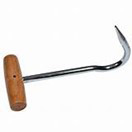I wanted to have a hook or two for my fall article – a hay hook to be precise.
 It hasn’t been a complete summer experience until you have had the experience of baling hay on a hot June or July day. Farmers typically rotated the crops. Corn was followed by beans. Oats or wheat followed beans, and hay completed the rotation. Farmers knew that rotation worked. We now know corn is a grass that uses a lot of nitrogen. Beans are a legume, which contains nodules on the roots containing a type of bacteria. The soybean provides the bacteria with carbohydrates, sugar and oxygen, and the bacteria converts nitrogen from the air into plant available amino acids that feed the plant. (Bradyrhizobia japonicum is the bacteria’s name). Oats or wheat used up the nitrogen and the hay helped put it back: a beneficial circle of rotation of taking out and adding back.
It hasn’t been a complete summer experience until you have had the experience of baling hay on a hot June or July day. Farmers typically rotated the crops. Corn was followed by beans. Oats or wheat followed beans, and hay completed the rotation. Farmers knew that rotation worked. We now know corn is a grass that uses a lot of nitrogen. Beans are a legume, which contains nodules on the roots containing a type of bacteria. The soybean provides the bacteria with carbohydrates, sugar and oxygen, and the bacteria converts nitrogen from the air into plant available amino acids that feed the plant. (Bradyrhizobia japonicum is the bacteria’s name). Oats or wheat used up the nitrogen and the hay helped put it back: a beneficial circle of rotation of taking out and adding back.
Midsummer was the time to bale hay. As soon as the wheat or oats came off, straw baling took place. A recent article about the Sheller farm prompted a memory of the time my son helped them bale hay. I was given the privilege of helping mow back the last two or three loads when I went to pick up my son.
Some farmers used elevators to put the hay into barns in upper lofts called hay mows, but many more used four large L-shaped hooks that were sunk in the opposite sides of a stack of four to six square bales. When I was younger, I drove the tractor that pulled the rope moving the forks and hay to the track in the ceiling of the barn and then to one side or the other of the driveway. When I got older, I had the privilege of stacking hay in the mow under a tin roof in 90-degree-plus weather. Coming down between loads, I would chill as my sweat-soaked shirt dried in the sun. A quart of lemonade was standard drink between loads.
Neighbors typically shared the cost of a baler and helped each other, as it normally took five or six to get the job done. Boys could typically stack four bales high on the wagon while stronger men sometimes made it five or six high. There was always one bale in the middle to help tie the load together. As the hay came out of the baler, the person standing on the wagon used hooks like the ones above to pull the bale onto the wagon and to help stack it. Some used one hook and some used two, both being careful not to pull one of the strings off and bust the bale. The job in the field was the dirty as the wind often blew the fine chaff into your eyes. Long sleeves were required to handle the hay stubble without scarring the arms.
As we become more urbanized, we lose many of the memories of working with friends, family, and neighbors. Such was a summer social occasion. At the end of the day, there was always a large meal and plenty of pie and homemade ice cream. Thanks, Shellers, for the memories.
Educational material and not legal advice, written by the team at Adler attorneys. Email andrea@noblesvilleattorney.com with questions or comments.

